Introduction
Scanautomatic is all about automation, manufacturing, and clever engineering solutions. Visitors come ready to see cutting-edge machinery and software in action—so why not showcase your company’s inventive spirit through engaging games that echo the fair’s industrial theme? Below, you’ll find 15 ideas that blend excitement, education, and a nod to the world of automation.
1. Physical Games
1. Giant Gear Toss
Concept: Picture an oversized “ring toss,” but instead of rings, players toss lightweight, foam “gears” onto tall rods shaped like robotic arms.
- How it Works: Each contestant has two attempts to land a gear on one of the rods. The rods differ in height, reflecting different levels of difficulty.
- Why It Works: It’s visually impressive—large gear props draw crowds and can’t be easily replicated at home. It also ties nicely to automation with the gear imagery.

2. Conveyor Belt Balance
Concept: Build a short, powered conveyor belt track. Players must guide a small crate (light but bulky) along the moving belt without letting it fall off.
- How it Works: The belt moves at varying speeds for a maximum of two minutes. Participants use handles on each side to gently tilt or adjust the belt’s track.
- Why It Works: It simulates a miniature industrial task, highlighting the importance of careful handling and real-time control—perfectly referencing process automation.
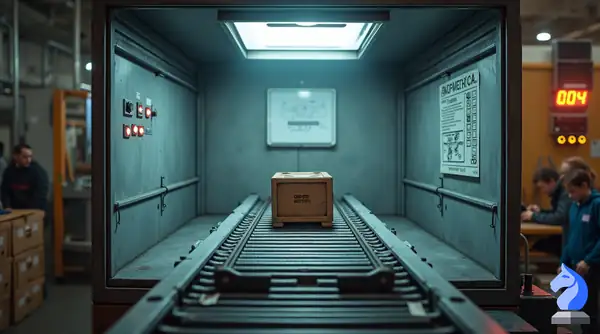
3. Robotic Arm Hoops
Concept: A motorized robotic arm (built into a sturdy booth) that players operate using a simple joystick panel. They have to pick up small “industrial parts” (like plastic balls) and drop them through a hoop.
- How it Works: The arm is set on a timer. Each player has two minutes to score as many hoops as possible.
- Why It Works: Operates like a crane game, but bigger, bolder, and reminiscent of modern manufacturing lines. It looks complex enough that fairgoers won’t imagine building their own at home.

4. High-Voltage Hammer Strike
Concept: Inspired by the classic fair “strongman” hammer game, but decorated with an industrial theme. Instead of a bell at the top, feature a “power gauge” shaped like an energy meter.
- How it Works: Attendees strike the lever with a big mallet to send a puck flying up the meter. The reading can be displayed digitally to highlight “electrical output.”
- Why It Works: It’s loud, classic, and physically engaging—everyone loves showing off a bit of strength in front of an onlooking crowd.
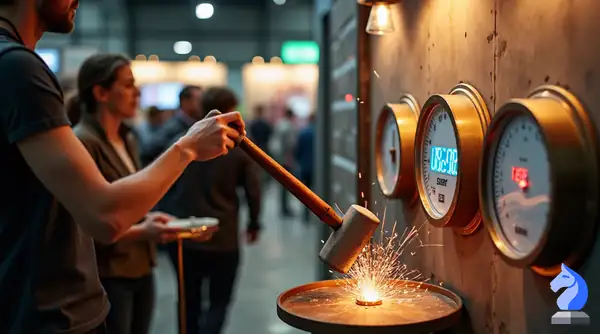
2. Digital Knowledge Game
5. Emergency Factory Shutdown
This game revolves around identifying correct versus incorrect emergency protocols in a factory automation setting.
- Story: A high-tech factory is on the brink of a meltdown due to a software glitch. Two engineers appear on-screen discussing urgent safety measures. The player must discern which protocols are valid and which are dangerous.
- Falling Items (Placeholders): Visualize them as small “safety cards” or “digital alert messages” dropping from the top of the screen. Some represent legitimate emergency procedures (e.g., “Activate coolant system”), while others contain flawed instructions (e.g., “Disable all safety locks immediately”).
- End Line: Depicted as a control panel with warning lights flashing. If a wrong item reaches this panel, it triggers a virtual hazard—symbolizing a meltdown scenario.
- Act of Shooting: The player uses a virtual “override tool,” which is essentially a click that sends an electric spark. In the story, it’s explained as the engineer quickly overriding or “zapping” erroneous commands before they harm the system.
- Meaningful Theme: Each correct item that passes through helps stabilize the system. Every wrong item that gets destroyed prevents a catastrophic chain reaction. The end result is a safe shutdown if the player manages to weed out the bad commands.
Why this works: It educates participants about proper emergency protocols in an automated environment while being fun and visually compelling. The storyline ties perfectly into industrial and process automation.

3. Digital Skill Games
In this category, we have two segments:
- Three existing, successful casual skill games that align well with an automation fair.
- Five newly designed game ideas specifically tailored for your booth.
3.1. Three Existing Market Games
6. Idle Factory Tycoon
- Stats & Gameplay: With over 10 million downloads on mobile platforms, Idle Factory Tycoon lets players manage production lines, hire workers, and automate manufacturing processes to earn virtual currency.
- Why It Matches: It directly references factory workflows and automation. Even though it’s an “idle” game, it teaches resource optimization in a simplified, casual format—an appealing extension of the fair’s theme.
7. Assembly Line (by Olympus Games)
- Stats & Gameplay: Assembly Line has surpassed 1 million downloads. Players design and optimize conveyor belts to manufacture everything from cars to electronics. It’s a puzzle-like experience requiring strategic thinking about part placement and timing.
- Why It Matches: It’s a lighthearted way to emphasize the efficiency challenges of a real factory. The quick-play style ensures players remain engaged in short bursts—ideal for a fair environment.
8. Automachef
- Stats & Gameplay: Automachef is a puzzle game available on multiple platforms. While not a high-volume mobile phenomenon like the others, it’s well-reviewed for its clever, brainteaser-style automation challenges.
- Why It Matches: It’s an actual automation puzzle: designing robotic kitchens. This can resonate strongly with an industrial audience, showcasing the fun side of process flow and machine-based solutions.
3.2. Five New Skill Game Concepts
Below are five brand-new concepts designed to be played within two minutes, each celebrating some aspect of manufacturing or process automation.
9. Rapid Circuit Tester
- Concept: Players must quickly tap on faulty spots in a schematic diagram of an assembly line circuit. Each circuit is displayed on a touchscreen and has a series of blinking zones.
- Gameplay: Faulty zones blink red. Players earn points for every successful tap within a limited time window. If they tap on a correct (non-faulty) zone, they lose a life.
- Why It Fits: Highlights the precision and speed needed for quality control in automated production lines.
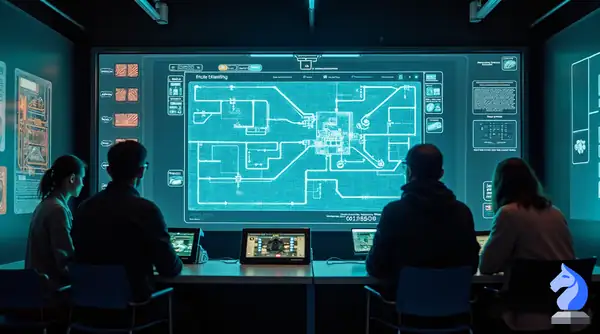
10. Robot Arm Relay
- Concept: On-screen, a series of small robot arms pass a component down a virtual conveyor. Each arm needs the correct input from the player at the right time to continue the chain.
- Gameplay: The player must quickly press or swipe in a particular sequence as soon as each robotic arm lights up. Failure to respond in time breaks the chain.
- Why It Fits: Emphasizes real-time synchronization, reminiscent of how automated lines must work in perfect harmony.

11. Laser Calibration
- Concept: A digital grid with reflective panels appears on-screen. Players must rotate panels to guide a laser from the start point to the target in under two minutes.
- Gameplay: Tapping a panel rotates it. Each rotation changes the laser’s path. The faster it’s done, the higher the score.
- Why It Fits: Laser-based measuring and cutting are common in manufacturing. This puzzle neatly references the precision engineering aspect of automation.
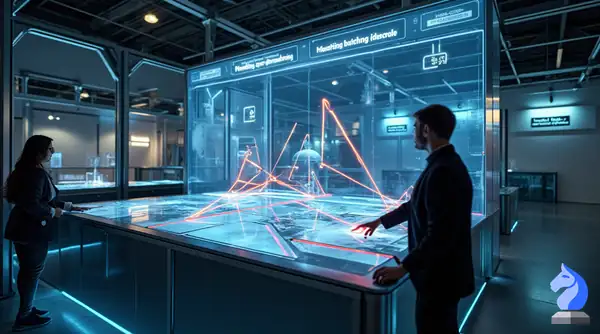
12. Material Sorting Rush
- Concept: Various raw materials (metal ingots, plastic pellets, circuit boards) appear on a conveyor belt on-screen. The player must drag them to matching containers before they fall off the end.
- Gameplay: It’s a simple swipe-and-drop mechanic. Each material has a correct bin. Mistakes or slow sorting reduce the final score.
- Why It Fits: Automated sorting is a huge part of modern manufacturing. This quick, frantic game conveys that feeling of urgency and efficiency.
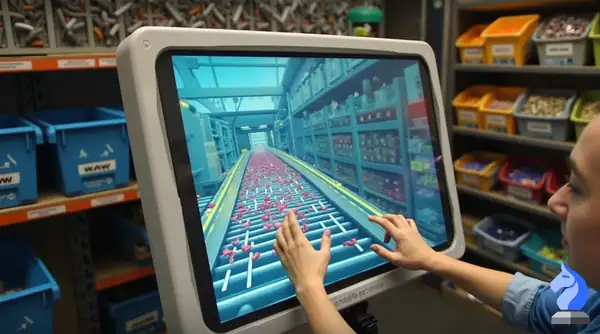
13. Blueprint Path Puzzle
- Concept: A blueprint with multiple pathways is partially scrambled. Players swap the puzzle pieces to make a single continuous track from the start point (raw material input) to the end point (completed product output).
- Gameplay: Only a handful of swaps are allowed, so players must strategize carefully. The puzzle must be completed within two minutes or less.
- Why It Fits: It simulates the logic of designing an efficient production line. Each correct path symbolizes smooth workflow in an automated factory.

4. Digital Chance Games
Finally, games of chance are crowd-pleasers and can be customized to reflect your company’s brand and industrial theme.
14. Customized Wheel of Fortune
- Concept: A large digital wheel with an industrial flair. Instead of the usual colorful wedges, the wheel is designed like interlocking gears.
- Design Twist:
- The center could feature your company’s logo encircled by a “factory dial” motif.
- Lights along each gear tooth illuminate as the wheel spins, suggesting a high-tech manufacturing vibe.
- The pointer can be shaped like a robotic arm that “locks” into each gear segment.
- Why It Fits: It draws attention from afar, it’s fun to spin, and it visually ties to automation. Ideal for quick, repeated plays with a prize element.
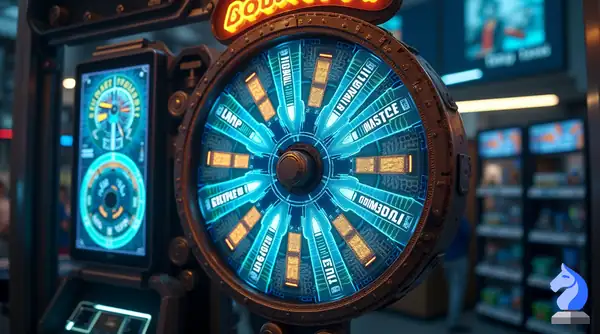
15. Jackpot & Plinko Combination
- Concept: Combine two crowd-favorites into a single booth. A digital jackpot machine reminiscent of industrial machinery, plus a vertical Plinko board that looks like an assembly line.
- Jackpot Machine:
- Design: Instead of fruit symbols, it features icons like mini robots, gears, conveyor belts, and PLC controllers.
- Industrial Edge: The lever or “spin” button could be shaped like an emergency-stop button or a futuristic control panel.
- Plinko Board:
- Theme: The pegs resemble “rivets” or “bolts,” and the disc itself is shaped like a metal part.
- Metaphor: As the disc bounces down, it’s akin to a component traveling through an assembly line with random outcomes.
- Why It Fits: Both are simple, luck-based games that people love to play. With the right industrial decorations, they align perfectly with the fair’s automation theme.
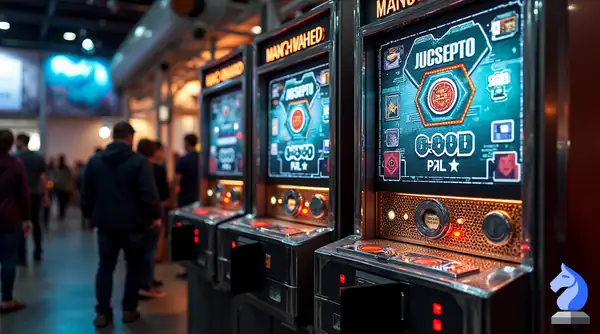
Conclusion
Whether it’s a high-energy physical challenge like Giant Gear Toss, an educational digital puzzle like Emergency Factory Shutdown, or a suspenseful chance game like the Customized Wheel of Fortune, each of these 15 ideas speaks to the core of Scanautomatic’s theme: manufacturing and process automation. By blending physical structures, bold digital interfaces, and a consistent industrial design language, you’ll ensure your booth stands out—and leaves a lasting impression—at the fair.
Feel free to mix and match these concepts or adapt them further to your unique brand messaging. Done right, they’ll not only entertain but also highlight your company’s commitment to innovation and automation. Here’s to a fair that’s both informative and unforgettable!

